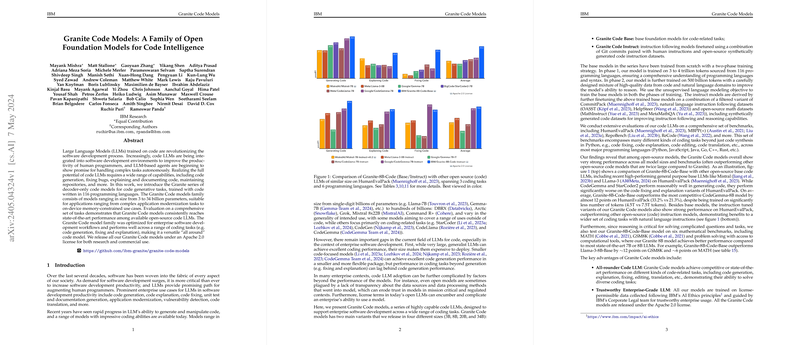Understanding Granite Code Models: Enhancements in AI-driven Software Development
Overview of Granite Code Models
Granite Code models present an innovative series of decoder-only LLMs trained on a diverse programming language dataset, showcasing strong performance across a range of software development tasks. These models range from 3 to 34 billion parameters, offering scalable solutions for both complex and constrained software environments.
Training Data and Model Architecture
The Granite Code models are trained on a dataset composed of code from 116 different programming languages, accumulating 3 to 4 trillion tokens. This training process is broken down into two main phases, emphasizing a comprehensive grasp of both coding languages and their syntactical nuances.
The architecture of Granite Code models is based on a transformer decoder setup, with configurations adjusted to optimize performance across different model sizes. Various model sizes incorporate unique techniques like RoPE embeddings, Grouped Query Attention (GQA), and Multi-Query Attention (MQA) for better efficiency and effectiveness.
Unique Features and Performance
The significant features of Granite Code models include:
- Versatility Across Coding Tasks: The models excel not just in code generation but also in fixing bugs, generating documentation, and other critical tasks that are part of the software development workflow.
- Optimized for Enterprise Use: They are particularly tuned to the needs of enterprise systems, managing to deliver reliable performance while ensuring data transparency and adherence to licensing requirements.
Evaluation Across Benchmarks
Granite Code models were extensively evaluated against several benchmarks, typically outperforming or matching state-of-the-art open-source models. For instance, they show notable results on benchmarks like HumanEvalPack and MultiPL-E by surpassing other models in tasks ranging from code generation across various languages to bug fixing and code explanations.
Future Directions and Accessibility
Looking ahead, Granite Code intends to extend the capabilities of these models further with updates that could include long-context models for more complex tasks, and versions concentrated on specific programming languages like Python or Java.
Additionally, a commitment to open-source is evident as all models are released under the Apache 2.0 license, broadening the scope for both academic research and industrial application, paving the path for broader adoption and continuous improvement.
The inclusion of these models into software development tools could significantly streamline coding tasks, reduce the incidence of human error, and subsequently decrease development times, highlighting the practical implications of integrating AI into everyday coding environments.
Implications for Data Scientists
For data scientists and developers, Granite Code models offer a robust tool that enhances productivity by automating a significant portion of coding workflows. The versatility across various programming languages and tasks makes these models an invaluable resource, especially in environments where quick adaptation to different languages or fast problem-solving capabilities are crucial.
Conclusion
In conclusion, Granite Code models mark a significant step forward in AI-driven software development. By combining robust performance with enterprise-focused features, they propose actionable solutions for integrating AI into software development, promising substantial gains in efficiency and effectiveness in coding practices across various sectors.
